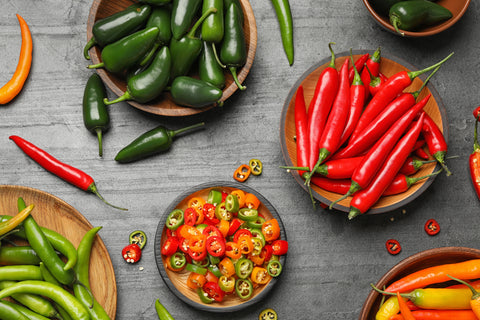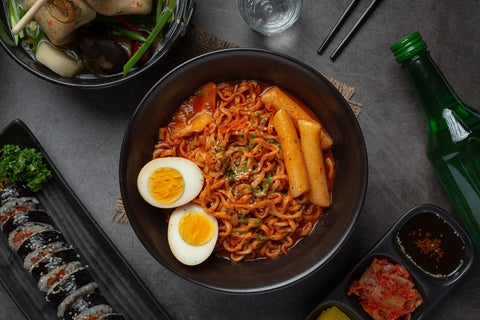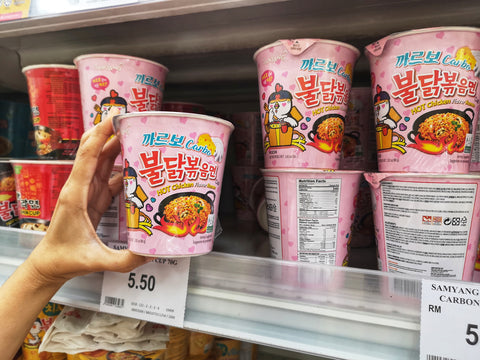Spicy Noodles Unleashed: A Fiery Tour Through Asia's Best
Spicy noodles are a popular kind of dish that packs a lot more heat than your average noodles. They are eaten all around the world but most especially in the Asian countries from which they originated. But these noodles don’t just offer spice. They also bring a flavorful and satisfying experience to the table. The actual noodles themselves taste like regular noodles, but their sauces, broths, and soups carry most of the spiciness, thanks to the addition of hot chili peppers.
Spicy noodles are served in China, Japan, Thailand, Korea, Singapore, Indonesia, and other Asian countries. From food stalls to noodle bars, you’ll find these dishes everywhere!
In this post, we take a deep dive into the various types of spicy noodles, their health benefits, their recipes, and lots more.
The Scoville Scale: Measuring the Heat in Spicy Noodles

Like we said, chili peppers typically give these Asian noodles the majority of their heat. To figure out just how spicy these noodles are, you need to understand the Scoville Scale, a tool used to express the level of heat or pungency in a pepper. It was invented in 1912 and uses the level of capsaicin (active chili component) in the pepper to determine spice levels.
The Scoville Scale works by assigning a Scoville Heat Unit (SHU) value to pepper based on its concentration of capsicum. The higher the SHU value, the spicier it gets. Different levels of the Scoville Scale are also compartmentalized to allow us to place peppers in heat categories ranging from mild to extreme hot. Below, we reveal the different heat levels on the scale and the corresponding chili peppers found in spicy noodle dishes:
-
Mild (0 - 2,000 SHU): bell peppers, sweet paprika, sweet peppers.
-
Mild Hot (2,000 - 50,000 SHU): tabasco sauce, jalapeno, cayenne,
-
Hot (50,000 - 100,000 SHU): chiltepin, Thai peppers, rocoto.
-
Spicy Hot (100,000 - 250,000 SHU): bird’s eye chili, habanero (milder variant).
-
Very Hot (250,000 - 500,000): Devil’s tongue red, fatalii yellow, habanero (hotter variant).
-
Really Hot (500,000 - 1,000,000 SHU): red savina, 7 pot yellow.
-
Fiery Hot (1,000,000 - 1,500,000 SHU): bhut jolokia, infinity chili, naga viper.
-
Extremely Hot (1,500,000 - 2,000,000 SHU): Carolina reaper, 7 pot douglah.
Any hotter than this and we’re heading into highly harmful territory. In this post, we may refer to the SHU value and heat levels of the peppers used to make spicy noodles, so keep that in mind as we explore these fiery dishes.
Health Benefits and Risks of Eating Spicy Food

Spicy foods like Asian-style noodles offer a lot more than just flavors. They may also provide you with some of the following health benefits:.
-
Supports cardiovascular health: Two of the biggest risk factors for modern heart diseases are high blood pressure and excess cholesterol in the bloodstream. Thankfully, several studies have shown that spicy foods help to reduce blood pressure and manage cholesterol levels in the body.
-
Provides anti-inflammatory benefits: Capsaicin in spicy food is known to provide pain relief and reduce inflammation by blocking neurotransmitters sending pain signals to the brain.
-
Helps with weight loss: People looking to reduce weight can enjoy the short-term benefits provided by spicy foods. These benefits include greater energy usage, suppressed appetite, faster fat burn, and improved metabolism.
-
Boosts human longevity: According to scientific studies, eating spicy food every day could lower the mortality rate by 12–14%. Numerous medical research projects have supported these figures.
-
Enhances gastrointestinal health: Capsaicin helps increase the amount of helpful bacteria that break down food in our gut. It also helps stomach ulcers heal by reducing excess acid in the body.
-
Prevents chronic diseases: The active components in spicy food can also help inhibit the growth of cancerous cells in the body. Hence, it may prevent cancer and other chronic diseases.
While spicy foods have so many health benefits, they also come with risks, particularly for people with certain medical conditions. They may not be the best option for patients suffering from Crohn’s disease or ulcerative colitis, as they could trigger flare-ups. In general, it’s best to eat spicy food in moderation, even if you don’t have an existing condition. Too much of it could result in the following symptoms:
-
Diarrhea
-
Nausea
-
Heartburn or acid reflux
-
Stomach pain
-
Vomiting
All of the health benefits and risks related to spicy food apply to spicy noodles. If you’re concerned about the stir-fried nature of these meals, we’ve got good news! You can get the JML Chongqing Spicy Noodles. They are delicious, hot, flavorful, and non-fried!
The Role of Fermentation in Spicy Noodle Sauces
The easiest way to bring heat to a noodle dish is to add some spicy sauce to it. This kind of sauce is also called hot sauce and is a staple in Asian cuisine. It could come in the form of a paste like Korea’s gochugaru, a thick liquid like Thailand’s sriracha, or a water-like seasoning like China’s chili oil. Hot sauces can also be either vinegar-based or fermented. To enhance the flavor and complexity of the sauce, most spicy noodle sauces undergo fermentation, a term that may sound complex but whose process is quite simple.
Chili peppers are mixed with salt, water, and additional ingredients in a jar or tank. The mixture is left in the container for weeks, months, or even years, allowing pH levels to lower as a result of the fermentation caused by microorganisms like bacteria. When it is sour, pungent, and tangy enough, the mixture is taken out, blended, and stored for consumption or sale. Some manufacturers add vinegar to their fermented peppers to further lower the pH and improve shelf stability.
Classic spicy sauces like Sriracha and Tabasco sauces are fermented for one to five years, ensuring maximum complexity and depth in their flavors.
Regional Varieties of Spicy Noodles Across Asia
Known as the birthplace of noodles, Asia has been the source of the world’s most popular noodle dishes for centuries. China is at the forefront when it comes to indigenous noodle dishes, but other countries like Korea, Japan, and Thailand have their own regional varieties too.
The regional ingredients and customs of the nation have a significant influence on these varieties. Remember that the majority of them were created centuries ago, which meant that people were limited to indigenous ingredients and cooking methods. Among all of these noodles, there are some that are characteristically spicy. We’ll take a look at the most popular of them and explore the diversity of spicy noodle dishes across different Asian countries.
The Art of Spicy Ramen: Japan's Fiery Bowl

Ramen is a staple noodle in Japan, consisting of wheat flour, water, kansui, and salt. It’s typically served in a spicy and umami-rich broth filled with a variety of meats and vegetables. Ramen is one of the few noodles that uses kansui, a mineral water also called Japanese lye water. This water is responsible for ramen noodles’ yellow color. Kansui also serves to keep the noodles from absorbing too much moisture. Hence, ramen has a firm and crunchy texture.
To make spicy ramen, you’ll simply have to use sriracha or chilli garlic sauce as an ingredient in the broth. Sriracha falls within 1,500 to 2,500 on the Scoville Scale, which means it offers mild heat. The heat level of the chili garlic sauce depends on the type of chili pepper used to make it. The mildest one is anaheim (500–1000 SHU) and the hottest is habanero (100,000 to 350,000 SHU).
There are four types of spicy soup based on their base flavor: shoyu ramen (soy sauce base), miso ramen (soy bean paste base), shio ramen (salt), and tonkotsu ramen (pork bone broth). Special noodles like Hikari Menraku Spicy Sesame contains the flavor of rich miso sesame broth to create the perfect umami experience as you slurp the dandan-style noodles.
Korean Spicy Noodles: A Symphony of Heat and Flavor

Korea is home to a wide variety of noodles, including hot noodles, cold noodles, spicy noodles, and chewy noodles. For the purpose of this post, we’ll only be looking at the spicy kinds of Korean-style noodles. Below, we’ll explore the unique aspects of the most popular Korean spicy noodles:
-
Jjamppong: This is a Korean dish inspired by Chinese cuisine. It consists of a spicy seafood or pork soup broth filled with gochugaru, a kind of Korean red chili powder. This powder is made from Korean red chili flakes, which are about 4,000–8,000 SHU and are considered mildly hot.
-
Bibim Guksu: During the hot summer, millions of people in Korea enjoy a cold and spicy noodle dish called bibim guksu. The spice in this dish comes from gochugaru (Korean red pepper powder), gochujang (Korean red pepper paste), and minced garlic.
-
Naengmyeon: Another summertime favorite and cold dish, consisting of noodles made from buckwheat or sweet potatoes. Bibim naengmyeon is the spicy variant of the dish and it can contain any hot sauce of your choice.
-
Spicy Ramyeon or Ramyun: This is the Korean version of spicy ramen noodles. Nongshim Shin Ramyun Spicy is one of the most popular instant ramyuns in Korea and the rest of the world. Samyang Ramyeon is another spicy Korean-style ramen, but it’s nowhere as spicy as Nongshim’s.
In Korea, these spicy noodles are a lot more than a staple diet. They are a cultural movement that continues to gain traction. The perfect example would be the Korean Fire Noodles Challenge. A YouTuber by the name of Josh started this social media trend. People would try to outdo each other by eating Samyang’s Buldak-Bokkeum-Myeon (Korean Fire Noodles). The challenge went viral on YouTube, generating millions of views and impressions!
Laksa: Southeast Asia's Spicy Noodle Soup Delight

Laksa is a spicy noodle soup from Southeast Asia known for its aromatic broth, which combines chili, coconut milk, and fresh herbs. The dish is native to Indonesia, Singapore, and Malaysia. Thick white or brown rice noodles are the most common types of laksa noodles. It also includes spicy coconut soup and toppings such as seafood or ground chicken. Laksa broth can be seasoned with a sour fruit called asam.
There are dozens of regional variations of laksa in the three Southeast Asian countries, where the doodle has become a symbol of culinary fusion and comfort. Most variations in Indonesia use a coconut milk-based soup spiced with pepper, garlic, candlenut, and turmeric. The variations in Malaysia and Singapore tend to use daun kesum or laksa leaf. Get a taste of Prima Taste Singapore Noodles: Wholegrain Curry La Mian to experience the authentic traditional spicy dish.
Spicy Peanut Noodles: A Nutty Twist on Traditional Flavors

Peanut noodles or peanut butter noodles sound like something invented in the 21st century. However, their roots extend all the way back to Shaxian, in Fujian, China. The dish consists of smooth or crunchy peanut butter, soy sauce, rice vinegar, seasoning, and chili oil. The chili oil, which is a chili-infused vegetable oil, brings a little bit of spice to this dish. However, to make it really spicy, add sriracha, red pepper flakes, and chili garlic sauce.
Shaxian Snacks is a company that opened in the region of the same name. They started as local street vendors for spicy garlic noodles but are now a global restaurant chain. Today, they sell a beloved dish that combines the creaminess of peanut sauce with the kick of chili to millions of people worldwide.
Crafting the Perfect Bowl of Spicy Ramen Noodles
Ramen happens to be one of the most basic forms of Asian-style noodles. You can easily turn up the heat on this dish by making a bowl of spicy ramen noodles using our simple recipe.
Ingredients needed:
-
Ramen noodles (any kind would work)
-
Sriracha (or any other spicy chili sauce)
-
Green onion
-
Ginger
-
Garlic
-
Sesame oil
-
Honey
-
Rice vinegar
Cooking procedure:
-
Cook the ramen noodles in boiling water. Follow all the cooking instructions on the package.
-
Chop the green onions, ginger, and garlic and mix with oil in a small pan. Fry the mixture for 3 to 5 minutes.
-
Add and whisk all of the other ingredients, including sriracha hot sauce, and let them simmer over low heat for about 5 minutes.
-
Add the cooked noodles to the heated sauce and let them simmer for a few minutes.
-
Taste the dish and if it’s not spicy enough, add more sriracha; if it’s too spicy, add soy sauce and honey instead.
Pairing Drinks with Spicy Noodles
No matter what kind of spicy noodles you make or buy, the right beverage will complement and soothe the heat. First of all, you can never go wrong with milk. It’s great for coating the heat with its thickness and providing immediate relief. Why go for ordinary milk when you can have Binggrae Banana Flavored Milk, a drink best paired with Korean spicy noodles? In fact, any kind of fruity cocktail or soft drink works well with spicy noodles. You can also try special teas like kombucha, green tea, and sour plum tea.
Spicy Noodles in Pop Culture: From Viral Challenges to Movies
Hot noodle dishes have appeared in many films and TV shows since the start of the 21st century. In the Academy Award-winning movie Parasite (2019), there is a food scene with some South Korean-style spicy noodles called jjapaguri, chapaguri, or ram-don. Two big critically acclaimed works with reference to Asian noodle shops are Kung Fu Panda (2008) and Hunger II (2023).
On social media, 2014 saw the Korean Fire Noodle Challenge go viral, increasing the popularity of Samyang Buldak Ramen and other fantastic Samyang products. Before then, a new emoticon was introduced in 2014 called the “Steaming Bowl,” and it was a depiction of ramen noodles.
Innovations in Spicy Noodles: New Flavors on the Horizon
A close look at emerging trends and innovations in the spicy noodle market will reveal new flavor combinations. The market now contains bolder and more exotic flavors that cater to certain demographics, such as Korea’s kimchi and Japan’s miso broth. Noodle brands, hot sauce companies, and restaurants are also collaborating more frequently. A recent example is the collaboration between the Momofuku restaurant and the A-Sha noodle manufacturer to create spicy soy noodles.
Lastly, there’s been an increase in plant-based options on the market. We have to recommend Kagoshima Vegetarian Ramen as a stellar example because of how well the manufacturers turned a traditionally pork and chicken broth dish into a delicious vegetarian delight!
Where to Find the Best Spicy Noodles

You can find authentic and delicious spicy noodles in Asian restaurants, food stalls, noodle bars, and markets. Earlier, we mentioned Momofuku, which is a pretty popular restaurant and food brand in the United States and other parts of the world. Visit any of their branches to enjoy authentic spicy noodles or buy the Momofuku x A-Sha Premium Instant Noodles we talked about. Many customers have given it a rating of 5 stars. You can trust Bokksu Market as your Asian market source for instant noodle packs and the ingredients you need to cook noodles.
The Endless Appeal of Spicy Noodles
Spicy noodles have been bringing people together and challenging taste buds in Asia for centuries, and now they’re doing the same around the world. Don’t miss out on this remarkable experience. Challenge your taste buds with a bowl of fiery noodles.
Author Bio










